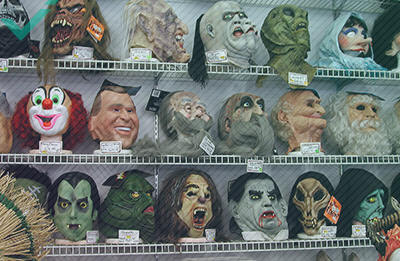What do Blue Öyster Cult, YogaMöm, and Häagen-Dazs all have in common?
They’re all popular brands who incorporate the umlaut—represented by two dots above a vowel—as part of their branding.
Where does the umlaut come from, and what does it mean? And most importantly, can you use the umlaut to give your brand that little something extra it needs?
WHAT IS THE UMLAUT?
The umlaut is a linguistic structure in which a vowel is pronounced more like the following vowel or semivowel. Vowel pronunciation varies with the position of the tongue and mouth, as depicted in the vowel chart. Some vowels are pronounced with the tongue forward, some with it back, some with it high in the mouth, and some low; the position of the lips, specifically whether or not they’re rounded, is also relevant. The umlaut takes the mouth position in which a vowel is pronounced and moves it closer to that of the following vowel. Check out this video to learn about how umlauts alter German pronunciation.

It’s important to note that “umlaut” refers to the sound, not the dots themselves, which are called the diacritic. The diacritic has other uses—in English, for example, it’s used to indicate diaeresis, or the separation of two vowel sounds which appear in succession, as in the words “Noël” and “naïve”.
HISTORY OF THE UMLAUT
The Germanic umlaut dates back to sometime between 450 and 500 AD. In medieval times, the umlaut was indicated by a tiny letter “e” above the modified letter. The umlaut was named by poet Friedrich Gottlieb Klopstock in 1774. It was popularised in 1819 by Jacob Grimm, one of the famous story-telling Brothers Grimm, who happened to also be a distinguished linguist. The word “umlaut” means “around sound”.

The Germanic umlaut came to influence all Germanic languages, including English. For example, the English plural of “foot” being “feet” is a result of the Germanic umlaut, as the words are descended from the proto-Germanic “fōts” and “fōtiz” (note that the additional vowel sound on the plural, an integral part of the initial umlaut modification, has been dropped). The pairs “tooth/teeth” and “mouse/mice” share a similar linguistic story. The greatest influence of the Germanic umlaut, however, remains in German, where umlauted vowels are spelled with specific letters: ä, ö, and ü. Some non-Germanic languages have umlauts as well, though theirs tend to follow different specific patterns: they include the romantic languages, old Irish, and Sami.
HOW UMLAUTS INFILTRATED THE MUSIC WORLD
In the 20th and 21st century, the history of the umlaut has taken a strange turn. It began to be used by non-German companies and artists to convey a certain European image, even by languages which do not themselves use the Germanic umlaut.
In the early ’70s, American rock band Stalk-Forrest Group changed their name to Blue Öyster Cult and hit it big with their eponymous debut album. With the help of their umlaut, they succeeded in conveying a morbid nostalgia and European Gothic mystique.
Other bands seeking to associate themselves with the mystery and menace of Teutonic imagery followed suit. Today, listing the bands whose names include an umlaut requires a whole Wikipedia page. Notable examples include Mötley Crüe and Motörhead, an American and British band respectively. The film This is Spın̈al Tap parodied this trend, with the titular American band umlauting an “n” instead of a vowel.
THE UMLAUT MAKES IT TO MAINSTREAM MARKETING
Meanwhile in the business world, the umlaut came to convey a very different set of European associations. In the 1960s, Polish immigrant couple to the Bronx Reuben and Rose Mattus founded Häagen-Dazs ice cream. They supposedly coined the name as a tribute to Denmark’s “exemplary treatment of the Jews during World War II”, despite the fact that Danish does not include an umlauted ä, and that the name is meaningless in Danish. No doubt the name was also chosen to invoke a reputation for European quality, craftsmanship, and excellence.
In 1980, Häagen-Dazs sued Frusen Glädjé for also using foreign branding strategies. They lost, and the floodgates burst open: dairy and frozen yogurt companies across North America began using gratuitous umlauts in their branding, from Atlanta-based Freshëns to Canadian Yogen Früz.
Nor is the trend limited to the dairy world: YogaMöm magazine, Söfft shoes for women, Seäsonal restaurant, and Melōränge melon attest to this.
That being said, the umlaut is not for everyone. Uber, the popular car-sharing app, took its name from the German word “über”, meaning over, and would have been well within its linguistic right to dub itself Über. However, it instead chose to anglicise its name, and go with the more streamlined Uber. If Uber’s example holds, it could mean a decline in umlaut-heavy branding.
PROS AND CONS OF USING THE UMLAUT IN BRANDING
Including an umlaut in your branding has its advantages, or else companies wouldn’t do it. It also has downsides. Here’s a list of pros and cons to help you decide if your branding strategy should include an umlaut.
PROS
The main pro of the umlaut is it conveys a sense of continental Europe, particularly to North American and British markets. Whether or not this is of benefit to you depends on what you’re trying to capture with your brand. If you’re trying to suggest European minimalism and classic quality, the umlaut might be a good choice. If you’re a metal band trying to embody Gothic mystery, tossing in a diacritic is also a good strategy (just make sure you place it over a vowel!). Once you have clear intentions around your brand, the choice of whether to go with the umlaut or not should be obvious.
CONS
The umlaut adds an additional element to your branding strategy, which inevitably increases complexity. An umlaut may make you harder to Google. It will make it so your URL won’t exactly match your brand name. It will virtually guarantee that your name will be inconsistent across media appearances.
If the umlaut doesn’t provide a net gain to your branding, don’t include it. But if the image you’re going for matches what the umlaut evokes, then it may be the cherry on top of a well-thought-out brand.
Working to craft the perfect brand? Connect with our team at Yuqo and we can help turn your branding ideas into a reality. We’ll help you craft every aspect of your online marketing strategy, down to whether or not your company name should include an umlaut. Contact us for your free custom analysis.


